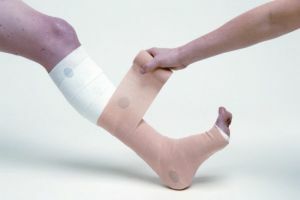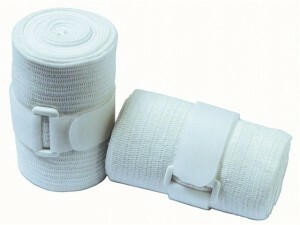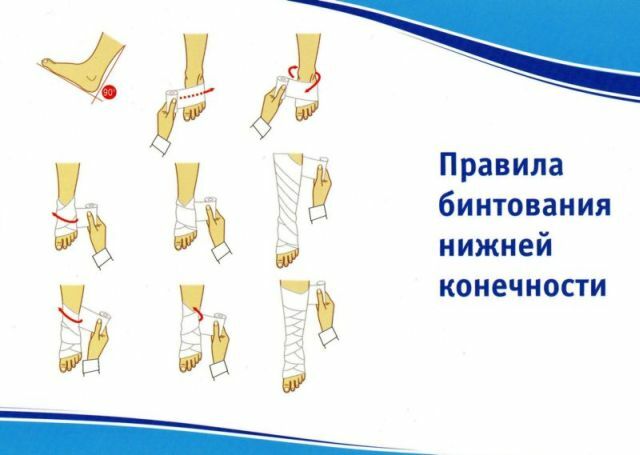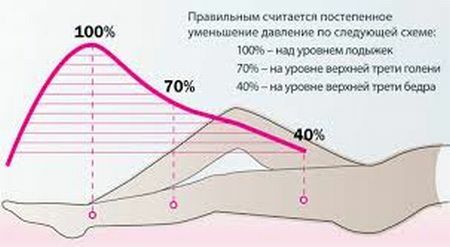 With varicose veins, pathological dilatation of the veins occurs and the valves are not able to prevent the return flow of blood in a normal volume. The consequence is overgrowing of the veins, the formation of edema, the appearance of thrombi.
With varicose veins, pathological dilatation of the veins occurs and the valves are not able to prevent the return flow of blood in a normal volume. The consequence is overgrowing of the veins, the formation of edema, the appearance of thrombi.
The use of bandages allows you to keep the veins in a normal state and prevents the progression of the disease. Bandages are not able to cure varicose veins, however, they contribute to the improvement of the condition and the disappearance of symptoms.
Contents of
- Types of used bandages
- Cons of use of elastic bandages
- What you need to consider
- Banding technique
- Typical errors
- Up to what level is the bandage needed?
- How much to wear a bandage and when to change it
Varieties of used bandages
There are several variants of bandages used for applying dressings for varicose veins. The difference can be, both the degree of extensibility, and in the composition.
The composition of elastic bandages are divided into fabric and knitted. It is worth giving preference to the fabric, so it is stronger.
According to the degree of stretching, the bandages are divided into:
- short extensibility( elongation slightly more than 50% of the original size);

- average ( stretching by 130-150%);
- with a long ( more than 150%).
Elastic bandages are bought both for the prevention of varicose veins, and as a treatment.
If the main goal is prevention, then you should give preference to a bandage with a long stretch. All other degrees of stretching are suitable for treatment.
The length of the bandages starts from 3 meters and ends at 10. Usually they buy and use the length - 4-6 meters. The width of the bandages does not vary with the length of 10 cm.
Cons of using elastic bandages
Despite the versatility of stretchable bandages( they can be used even during pregnancy), they also have disadvantages:
- the size of the foot in the foot and shin area is slightly enlargedThis is inconvenient when wearing shoes;
- in hot weather in a hot bandage is hot;
- is the likelihood of developing allergic reactions to substances in the composition.
What you need to consider
Using an elastic bandage it's worth to be careful and remember that:
- bandage can slip from the place of bandaging;
- excessive pressure may be applied to other sites not affected by varicose veins;
- it will be difficult to remove.
Banding technique
How to properly bandage your feet with an elastic bandage to treat and prevent varicose veins:
- After waking up, you should immediately bandage your feet. If you had to take a vertical position, then it's worth 10 minutes to lie down for the outflow of blood and lymph.
- The foot must be in a raised position during bandaging. The foot should be deployed and positioned at an angle of 90 degrees with respect to the shin.
- Binding begins from the ankle to the toes. And then back to the hip or lower leg. The heel must be seized.
- The subsequent turn must cover the previous one. In the lower part of the tibia, the coating should be tight, and as it approaches the knee joint and thigh, the overlap is permissible in half.
- A lock must be formed on the heel, which will prevent the elastic bandage from sliding down.
- Turn bandage should be higher by 10 cm from the visible varicose extension. This is necessary, since varicosity in some areas may be hidden.
- There should be no kinks and bends. The presence of foreign bodies is also unacceptable, since it will lead not only to inconvenience, but also to disruption of normal circulation of blood.
- Do not over tighten the elastic bandage excessively. In this case, the blood will not come in sufficient quantities.
- The fingers of the bandage should be open. They determine the correctness of the bandage application. In rest can be observed cyanosis( cyanosis), however, during the walk the blue is replaced by a normal pink color.
- Bandages are used individually for each leg.

You need to start the bandaging from the foot. The appearance of edema will indicate that the bandage tightens the vessels above the foot and hinders the outflow of blood.
How to tighten the leg with elastic bandage in varicose veins:
Typical errors
The following mistakes or unaccounted moments can be most common with bandaging:
- Binding only the site with varicose veins .Bandaged should be the entire leg, starting with the foot. The first coils should go from the base of the fingers. However, it is necessary to leave your fingers open, and to heel the reverse bandage.
- Opening of the heel is not advisable , since the venous plexus is located on the inner side of the ankle, which in most cases is enlarged in varicose veins. Since the pressure in this plexus is maximized, then with the development of varicose veins, the formation of trophic ulcers is possible here. To tightly bandage the heel, you can use the eight-way or spiral method. A more preferred method is the helix method, since the bandage is in the middle of the heel, which means that the entire
 dressing will last longer.
dressing will last longer. - During the bandaging, it is necessary to create a pressure difference .A denser bandage should lie in the area of the foot, and with a gradual ascent to the groin area - weaken.
- Bandage all over the limb should not be the same .In addition to pressure, the differences should be in the overlapping of the previous coil. From the bottom and up to a third of the shin, the overlapping of the turns must be two thirds. When lifting above, it is necessary that the next turn overlap half the previous one. The tension in the knee and shin area should be small, in contrast to the foot and lower leg.
- Do not make the tension too strong .At rest, pressure should be felt. But when walking this feeling should be pleasant.
Up to what level is the bandage needed?
Without ultrasound alone can not determine the affected area, so before applying bandages it is worth to visit a doctor. This is due to the fact that the veins in the groin area lie somewhat deeper than the tibia and varicose can visually not be detected.
If you decide to bandage your foot yourself, then do not finish bandaging in the middle of the shin. It is worth continuing to the knee or mid-thigh.
Thus, the bandage will hold better, and all invisible lesions, in most cases, will be bandaged.
How much to wear a bandage and when to change it
 Elastic bandages are worn constantly. The minimum period of wearing is one month. You can wear it periodically and it is recommended to combine in physical exercises and medications.
Elastic bandages are worn constantly. The minimum period of wearing is one month. You can wear it periodically and it is recommended to combine in physical exercises and medications.
Elastic bandage should be worn all day. After waking up and the morning shower it is important to bandage your legs so that the physical load does not aggravate the situation in varicose veins.
Before going to bed, you need to remove the bandages. However, there are cases when doctors recommend not to remove bandages even at night.
Bandages should be washed twice a week. Hand wash in warm water and using soap. To iron and squeeze elastic bandages is contraindicated. It is necessary to store them in a twisted form.
Correct bandaging of the legs with varicose veins allows to restore normal blood flow in the extremities and relieve unpleasant symptoms( swelling, fatigue, pain).Use bandages is regularly for a long time. It is necessary to shoot only at night or during bed rest.
